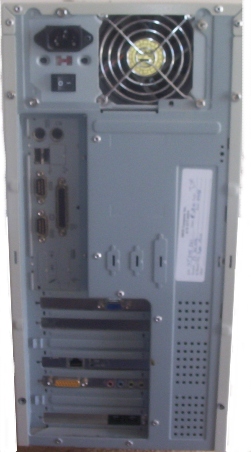Safety procedures
There are certain procedures you should follow when you are installing items in your system. Below is information to avoid damage to your system or/and yourself.
- Before entering the computer, move computer off the carpet (for static purposes). If your not able to then try not to move on the carpet to keep the static from building.
- Disconnect all cables including power cord. I can't stress this enough. Remove the power cord, monitor, keyboard, mouse, phone line, network cable, speakers, printer, scanner, USB cables, cable modem, DSL modem and anything else that is connected. (it should look similar to the picture below)
 |
- With everything disconnected, push the power button for 5 seconds. (with power cord disconnected). The computer can store power even with the power cord disconnected. Pushing the power button drains that power (only if the power cord is disconnected). VERY IMPORTANT!!!
- Touch something metal on the case of the system to release any static build up in your body.
- Computers are the best dust collectors. Do not blow on the dust with your breath. Your breath has moisture and electronics hate moisture.
- If you want to clean the inside of the system of dust, use compressed air that is designed for electronics.
- While using the compressed air, do not hold down the button. Not only will the can get cold, moisture will also form. Use quick short bursts.
- When handling parts, do not touch the bronze teeth. Hold the parts on the edges if at all possible.
- If you are troubleshooting noise issue, some people will stick a pencil or other objects in the fan to stop the fan from turning to see if the noise goes away. DON'T DO THAT! The fan might shatter the pencil, cause a fire, cause electrical shock or short.
- If you disconnect the cable that goes to the processor fan to check for noise, do not leave system on for long with it disconnected.
- Be careful while inside system, the system has sharp edges.
- Never put your hands inside system when the system is either plugged in or turned on.
- Some computer desks have a compartment that you can put your computer in. Make sure that compartment is well ventilated. If it is not ventilated, it can fry the system. If it is not well ventilated, you can drill holes in the desk to give it ventilation, or you can install a small fan in the desk that will circulate air.
- Do not connect or disconnect cables while the system or device is turned on. (unless it is USB. USB can be disconnected or connected while system is on). Equipment can be damaged by this.
****VERY VERY IMPORTANT NOTE****
If you have access to your personal files, make sure they are backed up before tinkering with the system. Sometimes there can be more than one issue and one of the issues may not show till you start tinkering with the system. For example, I have seen a hard drive be bad but it works as long as the system is on. However when you turn the system off, the hard drive doesn't work anymore. Once that happens, you can't get access to your files.
